Please Take Note: This is a review of the final game, but it might change slightly based on the success of the Kickstarter campaign. The game is being reviewed on the components and the rules provided with the understanding that “what you see is not what you might get” when the game is published. If you like what you read and want to learn more, we encourage you to visit the game’s web page or visit the Kickstarter campaign. Now that we have all that disclaimer junk out of the way, on with the review!
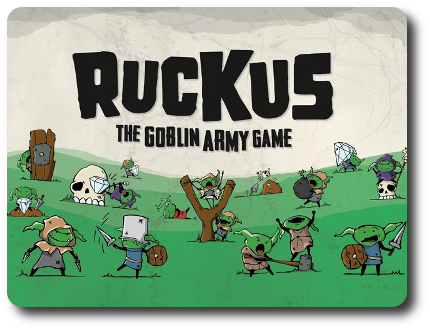
The Basics:
- For ages 8 and up
- For 2 to 4 players
- Approximately 20 minutes to complete
Geek Skills:
- Active Listening & Communication
- Counting & Math
- Logical & Critical Decision Making
- Reading
- Strategy & Tactics
- Risk vs. Reward
- Hand/Resource Management
Learning Curve:
- Child – Easy
- Adult – Easy
Theme & Narrative:
- Organize your goblin army and crush your foes!
Endorsements:
- Gamer Geek approved!
- Parent Geek approved!
- Child Geek approved!
Overview
To be a goblin means two things. First, you’re blessed with the inability to truly understand or appreciate danger. Some would consider this a fault, but goblins consider themselves to be very brave. Second, goblins have wonderful kings who tell them what to do. For example, charge a dragon. Having such wise leaders means goblins don’t have to think much, which is good, because thinking hurts. Get ready to lead your goblins to victory and certain chaos.
Ruckus, deigned by Matthew Papa and to be published by Goblin Army Games, will reportedly be comprised of 1 “First Player” token, 4 Battle Screens, 15 Victory Point (VP) tokens, 12 Victory cards, 25 Fighter Unit cards, 25 Thief Unit cards, 25 Cleric Unit cards, 25 Necromancer Unit cards, 6 Kicker cards, and 20 Damage/Skill markers. As this is a review of a prepublished game, we will not comment on the game component quality. The artwork by Rob Hughes, Mike Lubbers, and Rocky Ponce is excellent and compliments the game’s theme.
Know Thy Goblin
Ruckus features 3 different card types. They are summarized here.
Unit Cards
The majority of the cards in Ruckus are “Unit” cards. Units include fighters, clerics, thieves, and necromancers. Each of these units makes up a Guild, of which there are a total of 4 in the current game. Each of the 4 different Guilds uses different colored card fronts to make them easy to identify.
Each Unit has a level. The levels are “Starting”, “Level 1”, and “Level 2”. The “Starting” Units form the core of the players’ Goblin Guild. The “Level 1” Unit cards are only slightly better and more skilled than the “Starting” Unit cards, but are nonetheless an improvement. The “Level 2” Unit cards are the strongest and toughest of the Unit cards. In addition to identifying the Unit card’s overall strength, the level also represents the Unit card’s draft point value. These values are used when the players build their custom army.
Each Unit card will either engage their foes in melee or ranged combat, and have a shielded or non-shielded defense. While arrows and swords are excellent for down-and-dirty combat, a Unit’s skills are perhaps the most important weapon they have. A Unit’s skill is listed at the bottom of each of the Unit cards. Skills are either Active, Passive, or Reactive. Active skills sometimes need to be “socketed” by the player in order to be used (this is done by placing a Damage marker on the Unit card’s corner), Passive skills are activated when a specific event or condition occurs, and Reactive skills are a special sub-type of Active and Passive skills.
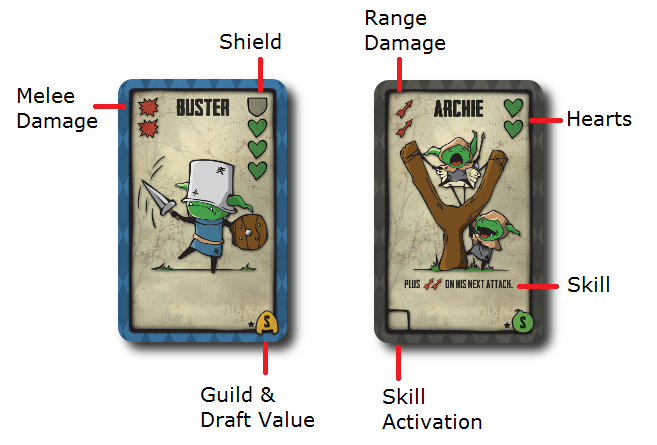
Kicker Cards
These cards provide the player with special moves when they engage their foes in combat. All Kicker cards are resolved when they come into play and discarded. When all the Kicker cards have been played, they are shuffled and returned to the Camp for future use by the players.
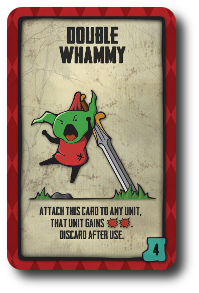
Victory Cards
Victory is a double-edged sword in this game. Victory cards will provide the player much-needed VP to win the game, as well as special actions that can be used before or after combat. However, Victory cards are not always completely beneficial to the player who claims them. They can take up valuable space in a player’s hand and disrupt Unit deployment to the battleground!
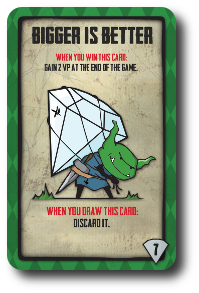
Game Set Up
Ruckus has three different game play variants. These are Basic, Advanced, and Draft. Regardless of which type is selected, a number of set up steps are always completed.
To set up the game, regardless of the game play variant used, first shuffle the Victory cards. Deal the top 5 Victory cards, face-up, to the Camp. This is the Victory deck for the duration of the game. The area the Victory deck is being placed is called the “Camp”. Place any unused Victory cards back in the game box. The top card on the Victory deck is placed directly below the deck. This is the first Victory card the players will be competing for via combat. The top card on the Victory deck is the next Victory card to be squabbled over in subsequent rounds.
Second, the Victory Point tokens are placed in the Camp, face-down, and randomized. A Victory Point token’s face will either have a Victory Point number value (a “1” or a “2”), a Melee combat symbol, a Ranged combat symbol, or a Heart symbol (which will improve a Unit card’s overall health).
Third, shuffle the Kicker cards and place them face-down in the Camp. This is the Kicker deck. Leave room next to the Kicker deck for a discard pile.
Fourth, place all the Damage/Skill markers in a pile in the Camp and place the “First Player” token next to it.
Sixth, each player randomly draws a Kicker card. Each Kicker card has a number value. The player who drew the Kicker card with the lowest number is the first player. This player is passed the First Payer marker and the Kicker cards are reshuffled.
Seventh, give each player a Battle Screen. This completes the shared set up steps for each of the 3 game play variants. Depending on which game play variant was selected, the game set up continues as follows.
For Basic Game Play
Hand to each player a complete Goblin Guild (Unit cards all comprised of the same color) deck. Each player will then find and set aside each Unit card that has a star next to the Unit’s level value. The starred Unit cards, when combined, create a fairly well-balanced army for new players to use. The remaining Unit cards are collected from all the players, shuffled, and placed face-down in the Camp to form the Upgrade deck. Any Goblin Guild decks not selected are placed back in the game box.
This is a great way to introduce the game and I highly recommend you play Ruckus using this game play variant at first. Players shouldn’t worry about which Guild they select or be upset if they don’t get the Guild they wanted. Goblins from all the Guilds can later be added to an individual player’s army!
For Advanced Game Play
Again, hand to each player a complete Goblin Guild deck. Each player should find and remove each Unit card that has an “S” as a level value, indicated it’s a “Starting” level Unit card. Each player then has 12 draft points to spend to add additional Unit cards from their Goblin Guild to the Starting level Unit cards. A Unit card’s level equals its draft point value. The players are welcome to draft any Unit cards they like from their specific Goblin Guild deck as long as the total sum of the drafted Unit card level values does not exceed “12”. The remaining Unit cards are collected from all the players, shuffled, and placed face-down in the Camp to form the Upgrade deck. Any Goblin Guild decks not selected are placed back in the game box.
For Draft Game Play
This game play variant is completed using the same procedures as the Advanced game play, except for one very important difference. Once the Starting level Unit cards have been set aside, ALL the remaining Unit cards are placed face-up. Starting with the player with the First Player marker and continuing in turn order sequence, players take turns drafting from the face-up Unit cards. The players are welcome to draft any Unit cards they like from the Goblin Guilds as long as the total sum of the drafted Unit card level values does not exceed “12”. Any Unit cards not drafted are collected from all the players, shuffled, and placed face-down in the Camp to form the Upgrade deck. Note that this game play variant will create unbalanced armies. Any Goblin Guild decks not selected are placed back in the game box.
When completed, the Camp will look something like the following with each player safely hiding behind their Battle Screen with their starting goblin army.

That’s it for game set up! RELEASE THE GOBLINS OF WAR!!!!
Tiny Green Combat
Ruckus is played in 5 Combat rounds. Each Combat round is comprised of multiple phases. I will only summarize the phases here with the understanding that a player will be putting more time and thought into each phase than what I suggest in this review. See the rule book for a more detailed description with examples.
Phase 1: Draw and Formation
The first phase requires the players to shuffle their Unit decks and then draw 5 Unit cards. These represent the goblins that will be fighting for the player this round. The remaining cards in the Unit deck are placed face-down behind the player’s Battle Screen.
Players must now place their goblins in a formation behind their Battle Screen. There are 3 rows the player can use. The first row is the closest to the Battle Screen and represents the front lines. The second and third rows are behind the first row. The first row cannot contain any more than 3 Unit cards, the second can only contain 2, and the third can only contain 1. These are limits, not requirements. A player could place only 1 Unit card in the front row if they wanted to.
Note that the limit to 5 Unit cards and the number of Unit cards in the rows is the default. As the game continues, players will have a chance to draw more Unit cards and build stronger rows. If a player is ever unable to draw 5 cards, they take their discard pile and shuffle it. If the player has won previous Combat rounds, they might draw a Victory card. The player does not get to draw a new card if they do!
Once all the players set up their formation, the Battle Screens are lifted and the next phase begins.
Phase 2: Activation
Before battle begins, all players have an opportunity to use 1 skill. Starting with the First Player and continuing in turn order sequence, each player can optionally select one of their Unit cards in their formation to activate a skill noted on the Unit card. Once all the players have selected a skill to active, they are resolved. Note that some skills do not trigger until a certain condition is met and some skills might triggers automatically based on other skill activated during this phase.
Once all the skill activation have been resolved, the next phase begins.
Phase 3: Declaration
Each player now adds up their total attack damage with any skill bonuses. This is done by counting the melee, ranged, and any skill bonus damage noted on their Unit cards.
Phase 4: Resolution
Melee damage can only target the Unit cards in the front row. If there is still more damage to be dealt after the entire from row of Unit cards has been destroyed, the extra damage is ignored. Ranged damage can hit any Unit cards. The player who is taking the damage can assign it to any of their Unit cards. Sometimes, as is the case with melee damage, the player must assign it to their front row. Otherwise, they are welcome to divide it up however they like.
Shields automatically “absorb” 1 damage, but any damage not blocked reduces a Unit’s Heart value by 1.
Phase 5: Damage
After each player knows their total damage output for the round, the player who has the highest total value deals that amount of damage to ALL their opponents. Then the player with the next highest deals their damage only to the player who had the highest total. Confused? Don’t be.
In a 4-player game, the total damage equals “4”, “3”, “2”, and “2”. The player who had the “4”, deals 4 damage to all their opponents. The player who had the “3” then deals damage to the player who had the highest total damage (in this case, the player with the “4”). The other two players do not count their damage. In a 3-player game, one player will not do damage to their opponents, but in a 2-player game, both players will damage each other.
Damage is now assigned and any Unit card that suffers damage equal to the number of Hearts they have on their Unit card are discarded in the player’s personal Unit discard pile.
Players now have an opportunity to move their Unit cards forward to fill in any gaps.
Winning the Combat Round
The Activation, Declaration, Resolution, and Damage phases are repeated until 1 player is the only one left with Unit cards in play. This player wins the Combat round and collects the Victory card, which is placed in the player’s discard pile along with any Units they lost during the round.
Phase 6: Upgrade
The battle now continues! Any player who lost the Combat round can now upgrade. In turn order sequence, starting with the First Player, each player can select 1 Unit card in their discard pile and remove it from the game. They then draw 1 Unit card from the Upgrade deck in the Camp and place it on top of their Unit deck (not their discard pile).
The First Player marker is then passed to the next player going clockwise. This completes the Combat round. If there are still more Victory cards to be won, the game continues. Otherwise, the game comes to an end.
Winning the Game
After the fifth Victory card has been claimed, the game comes to an end. All the players now add up all the Victory Point values they have collected. Any unused “Heart”, “Melee”, and “Ranged” Victory Point tokens not used are worth 1 victory point each. The player with the most victory points wins!
To learn more about Ruckus and read the full rules, visit the game’s web page or visit the Kickstarter campaign.
My friend Tox over at Crits Happen did a great video preview of the game if you would like to see more visual examples.
Prediction
Ruckus has a lot going for it right out of the box. The game is flexible to a point where the learning curve can be adjusted without dumbing down the game. The level of tactics and strategy is also flexible, allowing for a casual game or what would appear to be a real thinker. The rules are very straightforward, but I am somewhat concerned about the overall game flow. From just reading the rules, it sounds like the game gets a bit mathy when adding up damage. Resolving skills that trigger other skills and so on might get a bit confusing, too. There are a few cards mentioned in the game set up, but are not discussed further in the rule book. This might indicate a rule book that still needs work or the cards in question are introduced through game play. We’ll have to play Ruckus to find out.
Overall, I think the game will be well received by the Parent and the Gamer Geeks, with the more “geeky” Parent Geeks enjoying it much more than the non-gamer Parent Geeks. There is a lot of shifting of cards around and making specific choices that target other players that might feel a bit heavy to the non-gamers. As for the Child Geeks, I have no doubt they’ll enjoy the card artwork, but the math and the multiple skill effects might be a bit too confusing for them at times, thus reducing their level of excitement. I hope not, but again, based on the rules the game sounds a bit heavy at times during the Declaration and Resolution phase.
I taught Ruckus to my 9-year-old and only introduced it to the Child Geeks who could read. Ruckus does require it’s players to read and understand how the skills could be triggered. The game also requires the players to figure this out on their own. The blind deployment is an awesome way to have each player set up their armies behind the Battle Screens, but another player cannot assist an opponent as a result. My 6 and 4-year-old were happy enough just looking at the cards and making up their own games with the game components.
After teaching Ruckus to my 9-year-old, which was surprisingly simple, I asked him his thoughts on the game so far.
“A really neat idea! I like how we get to build up a goblin army and make up different groups! Let’s play!” ~ Liam (age 9)
Yes! Let’s get the game on the table and play it with friends and family!
Final Word
The Child Geeks liked Ruckus right from the start. It reminded a number of the older Child Geeks of Pokémon, with each Unit card representing a unique goblin who had fun abilities to take advantage of. Overall, the Child Geeks demonstrated smart card plays and clear understanding of the game’s most basic strategies and tactics. Only the older Child Geeks were able to pull off some interesting combos and excellent reactionary skills. The younger Child Geeks mostly just “acted” or “reacted”, but seldom did both. According to one of the younger Child Geeks, “I like this game because I feel like the goblins are really fighting!” An older Child Geek said, “This game makes me think before I play my cards, but the game is easy to play. Just really hard to win!” All the Child Geeks voted to approve Ruckus, finding it to be a delightfully chaotic game they felt like they could control.
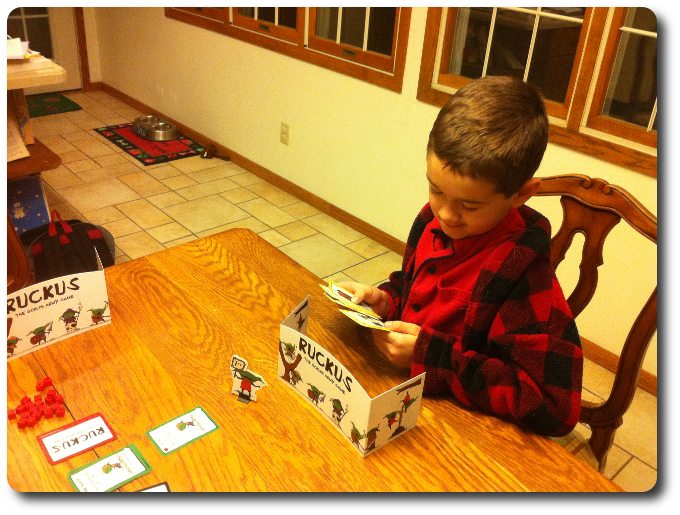
Our second game of Ruckus in the evening and he’s still smiling!
The Parent Geeks slowly warmed up to the game, but once they saw how much freedom they were given when building their army and the fun ways to chain card effects together, they were hooked. The more casual and non-gamer players were less thrilled about Ruckus, but nonetheless enjoyed themselves, too. According to a non-gamer Parent Geek, “This is not a game I would think to play, but I’m really happy I did.” A more “geeky” Parent Geeks said, “This is a great game to play with my friends and my family!” Yes, but why? Most of the time, the answers were focused on the “easy game play” and “fun card interaction”. Only a few of the Parent Geeks mentioned the game’s depth and the level of strategic and tactical choices that were available. Which should not suggest that there weren’t any to be had. Rather, I think it more likely that the Parent Geeks were too wrapped up in the fun they were having to take a moment to stop and reflect on the game’s depth. Makes sense, really. Why stop to consider how deep the pool is when you are having fun splashing at the surface? All the Parent Geeks voted to approve Ruckus and enjoyed it most when their Child Geeks kicked the Parent Geeks’ butts.
The Gamer Geeks approached Ruckus with an open mind, but with a few negative assumptions. For example, they mumbled things like “this is War with little green men” and “at least it’s not zombies”. I decided to use the Draft game play variant right from the start and this required our Gamer Geeks to sit up and lean forward at the gaming table immediately. By drafting their armies, the Gamer Geeks had much more control over their cards and the creation of combos. The more enthusiastic of the Gamer Geeks really got excited about the drafting and did an excellent job of picking out Units that complimented each other. A few Gamer Geeks just drafted seemingly at random. In the end, all the Gamer Geeks found Ruckus to be an engaging and fun strategic card game with a surprising amount of tactical choices to be made. The Gamer Geeks who didn’t think much about what Units they drafted wanted to play another game immediately, as they were totally destroyed by their more thoughtful opponents.
Every once in a while, a game surprise me. Ruckus is such a game. The method in which the game is played out is surprisingly elegant, wonderfully strategic, delightfully tactical, and immensely satisfying. Whether I played with 2 players or 4, the game always delivered a rewarding and entertaining experience. The three different methods of game set up provided our players with 3 different approaches that allowed each of our 3 groups to enjoy themselves, but more importantly, it provided meaningful choice.
It is the level of choice given to the players that I believe is the game’s greatest strength. A player is always given multiple paths, but none of them are difficult to traverse. What remains hidden is the final outcome, but that is also part of the game’s fun. A player can plot and scheme all they like behind their Battle Screen, but the real trick is creating a vanguard of goblins that is tough enough, resistant enough, and versatile enough to counter the opponent’s army. That can be downright tricky and the stakes are high due to the game’s short play time.
Ruckus is wonderful, delightful, and thoroughly entertaining. It’s one part card game, one part wargame, and full of goblin goodness. The rule book needs some work, as there were a number of times we had questions the rule book didn’t answer. But as this is a yet to be published game, we didn’t count this as a negative. Regardless of some of our head scratching, we found Ruckus to be a great game that provided a great experience for all those who had the pleasure to play it. Do take a look at Ruckus when time permits.
This is a paid for review of the game’s final prototype. Although our time and focus was financially compensated, our words are our own. We’d need at least 10 million dollars before we started saying what other people wanted. Such is the statuesque and legendary integrity of Father Geek which cannot be bought except by those who own their own private islands and small countries.




Game looks like a lot of fun I wonder what it’ll sell for!
Currently on Kickstarter for $29: http://www.kickstarter.com/projects/268844631/ruckus-the-goblin-army-game
Pingback: Today in Board Games Issue #107 - Today in Board Games